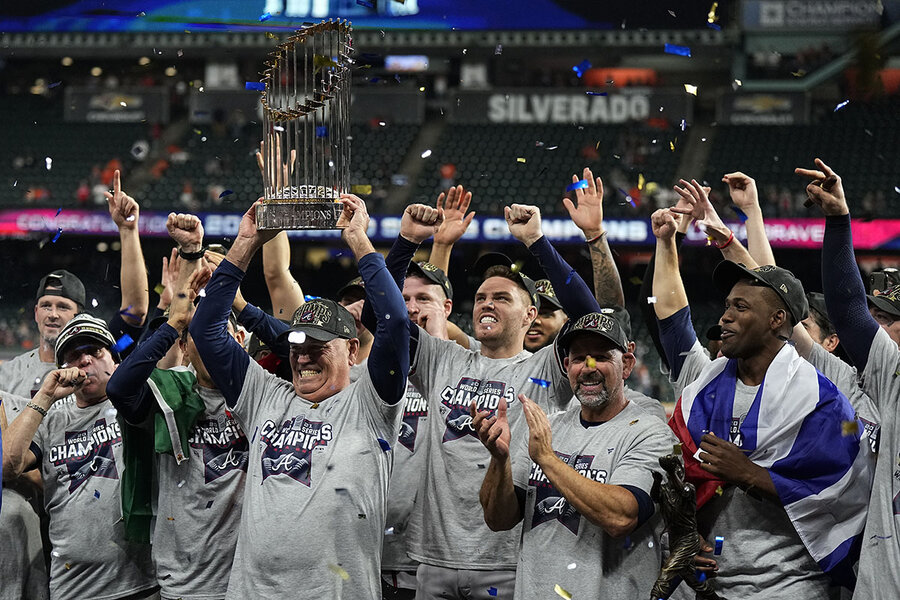Play ball? What baseball’s lockout means for the sport – and fans.
Loading...
Baseball is dealing with its first work stoppage in almost 30 years. The current lockout, which so far has canceled opening day and some early-season games, is a lesson in the complicated business of America’s pastime.
When it comes to confusing concepts like salary arbitration and the competitive balance tax – intended to keep the highest-earning teams from dominating with money alone – the players and owners feel that what’s good for one side is bad for the other.
Why We Wrote This
Baseball was already struggling before players and owners recently reached an impasse. How the negotiations are handled could bring needed changes – or affect baseball’s viability long term.
Beyond that, the two sides – which have made some concessions this week in an effort to prevent more cancellations – are debating proposals to expand the number of teams in the playoffs, how much revenue big-market teams should share with smaller markets, and a host of rule changes from pitch clocks to bigger bases. Game play, though, is less important right now to negotiations than is revenue.
What’s ultimately good for players, owners, and fans is to stop canceling games and reach a deal, sports economists say – especially since the sport has been struggling with record low viewership.
“It’s really a game of chicken here,” says J.C. Bradbury, an expert on baseball economics at Kennesaw State University. “Who’s going to flinch first?”
Negotiations on a new collective bargaining agreement between Major League Baseball and its players’ union have been one, two, three strikes and out – pushing the sport to its first work stoppage in almost 30 years.
The current lockout – which so far has canceled opening day and some early season games – is a lesson in the complicated business of baseball. When it comes to confusing concepts like arbitration and the competitive balance tax, the players and owners feel that what’s good for one side is bad for the other.
But, as baseball struggles with record low viewership and record high game length, what’s ultimately good for players, owners, and fans is to stop canceling games and reach a deal, sports economists say.
Why We Wrote This
Baseball was already struggling before players and owners recently reached an impasse. How the negotiations are handled could bring needed changes – or affect baseball’s viability long term.
What is a lockout?
A lockout is when owners won’t let players play. That doesn’t mean the current impasse is all the owners’ fault, though.
More than 50 years ago, players formed the Major League Baseball Players Association (MLBPA) to bargain for better working conditions with the team owners. Since 1968 they’ve done so every several years through a collective bargaining agreement, or CBA, which is essentially a giant contract defining the sport’s rules and finances.
The last CBA was signed in 2016 and expired last year. In part because many players don’t feel the recent deals have been fair, the two sides couldn’t reach an agreement by the Dec. 1 expiration date, which launched the current lockout.
Why can’t players and owners agree?
The players and owners want opposite things, and both sides are focused almost only on finances. The business side of baseball is a game of its own, and it’s a zero-sum game.
“It’s really a game of chicken here,” says J.C. Bradbury, an expert on baseball economics at Kennesaw State University in Georgia. “Who’s going to flinch first?”
Both sides have reportedly made some concessions this week in an effort to prevent more cancellations. But the sense that one side’s gain is the other’s loss has been guiding the proceedings, and is most powerful when it comes to the competitive balance tax and arbitration.
Unlike other major American sports like football and basketball, the MLB has no salary cap. That means every team can spend as much on players as it wants, up to a limit. That limit comes in the form of the competitive balance tax (CBT), intended to keep the highest-earning teams from dominating with money alone. If a team’s 40-player payroll exceeds a certain threshold ($210 million in 2021), then every dollar spent above it is taxed with an additional 20% fee – a rate that rises each consecutive year a team exceeds it. The idea is to limit spending so teams like the Miami Marlins can compete with teams like the New York Mets.
The owners want to keep the CBT threshold low and tax rate high for another reason though: They want to increase profits by lowering costs. Meanwhile, players want to earn more. The higher the threshold for the CBT, and the lower the tax rate, the more they can earn.
The same incentives apply to arbitration, baseball’s unique, arcane contract system for new players. Right now, players with expiring deals and at least three years of service – and two-year players in the top 20% of service time – may negotiate a new contract with their team. In an effort to let younger players bargain for more money, the MLBPA wants to make two full years the new threshold. The owners do not.
Beyond that, the owners and players are debating proposals to expand the number of teams in the playoffs, how much revenue big-market teams should share with smaller markets, and a host of rule changes from pitch clocks to bigger bases. Gameplay, though, is less important to negotiations than revenue.
“The financial issues right now are paramount,” says Tim DeSchriver, associate professor of sport management at the University of Delaware.
What does it mean for baseball?
It could mean a long stretch of dog days. Baseball’s last work stoppage in 1994 was disastrous, canceling an entire postseason and the World Series. The next year, attendance fell 20%, and it didn’t recover for years.
A prolonged lockout now could add another unwelcome challenge to baseball’s roster. Between 2019 and 2021, MLB viewership dropped 12% and attendance dropped 33.9%. Pre-pandemic revenue was at an all-time high, says Professor DeSchriver, but attendance had fallen, and canceled games could push even more fans away.
Baseball’s attention should really be on the things that fans care about: speeding up gameplay and increasing on-field action amid record-low batting averages, says Ryan Eckert, a historian at Monmouth University in New Jersey and author of “A Game of Failure: The 1994-95 Major League Baseball Strike.”
“It’s about the future,” he says. “Nobody wants to start down a path where they’ll be in an even weaker position years from now, when the popularity and the profitability of the game overall is not trending upwards.”








